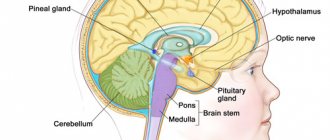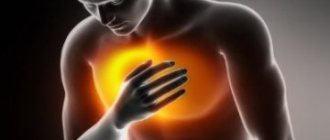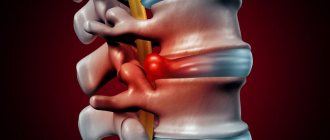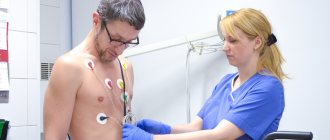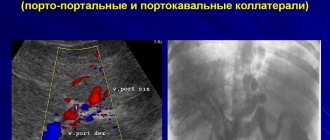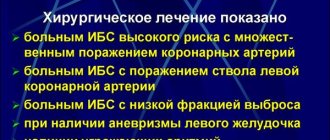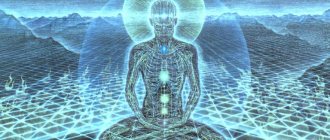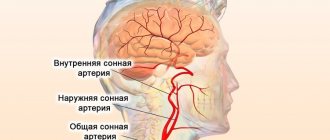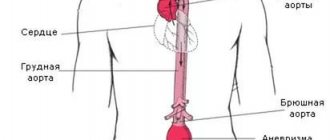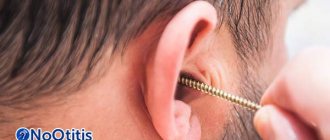Patients who call themselves “heart patients” and have symptoms of cardiac neurosis constitute a fairly impressive group among all functional disorders of the nervous system. They often visit doctors, undergo various examinations, and call an ambulance. Such patients willingly try various heart medications on themselves, and the latest innovations found in the virtual space bring considerable income to experts in alternative medicine, and sometimes to simply charlatans. Their suffering is genuine and incomparable.
Why does cardiac neurosis or neurosis in general occur?
In most cases, in the clinic of neuroses of this kind, a pseudoneurotic psychovegetative state called cardiophobia syndrome occurs. This health disorder, which accompanies the symptoms of heart neurosis, is due to many reasons:
- Individual characteristics of the nervous system, which are often characteristic of the asthenic type;
- Neurocirculatory dystonia;
- Arterial hypertension;
- Hormonal changes during certain periods of life (pathological menopause), which often gives three combined symptom complexes:
- autonomic neurosis,
- neuropsychiatric syndrome,
- sexual dysfunction and sexual disorders;
- Negative impact of industrial hazards, environmental factors and alcoholic beverages;
- Chronic infections (otitis media, tonsillitis, etc.).
Meanwhile, the main reason for the formation of cardioneurosis is rightly considered to be a traumatic situation that arises from time to time or is constantly present and, of course, the attitude of the person himself towards it.
When are heartaches directly related to emotions?
Cardioneurosis has a variety of symptoms, but cardialgia and panic attack are the most striking and common manifestations of the disease. They often represent an independent pathology (psychasthenia, neurasthenia, hysteria, obsessive states), which, however, is often attributed simply to character traits, and the patients are not similar to each other.
For example:
- People prone to hysteria are self-centered, mannered, and loud;
- Psychasthenics, on the contrary, are quiet, shy, constantly feeling self-doubt, and therefore cannot solve even simple life problems;
- The most complaints, including cardialgia, are made by neurasthenics. Everything hurts, their sleep is disturbed, their “nerves are shattered,” their appetite is reduced, they are plagued by various autonomic disorders (tachycardia, sweating, decreased ability to work), they are easily excitable, so they often find themselves in the center of a conflict situation.
Signs of obsessive-compulsive neurosis from these groups are most characteristic of psychasthenics, since they are suspicious by nature, they are often tormented by a feeling of their own inferiority, and are visited by unreasonable fears and obsessive thoughts. However, no matter how striking the differences between these psychotypes are, functional disorders of individual organs often arise against their background. Of course, the heart comes to the fore, then the head, gastrointestinal tract, etc. Cardialgia is perhaps the main and most common complaint of patients suffering from neurosis. If the patient primarily focuses on his heart, and other symptoms fade into the background, then it is customary to talk about cardiac neurosis or cardioneurosis. Cardiac neuroses are most common in people with neurasthenia.
Does your heart hurt or just seem so?
Pain in the heart during neuroses can be considered an almost natural phenomenon. Due to the fact that people suffering from neurosis are characterized by pronounced emotional lability, cardialgia in them can be triggered by excitement, expectation, and conflict. In a word, everything is built on emotions, not only negative, but also positive (having learned the good news, a person “grabbed his heart”).
Pain in the heart during neuroses can be fleeting or last for months; sometimes they occur paroxysmally and accompany a panic attack. Thus, the main signs of cardiac neurosis can be considered:
- Dull, stabbing, squeezing pain behind the sternum, in the nipple area, radiating to the neck, shoulder blade, arm, accompanied by shortness of breath, reaching the point of suffocation. Fear, anxiety, fear of death, as a rule, are companions of cardialgia. The ambulance called does not find any signs of heart damage, and the recorded ECG does not register any changes. However, in some cases, neurogenic cardialgia can cause vascular reactions
(cardiovascular neurosis), leading to spasm of the coronary arteries, which, in turn, threatens to impair coronary circulation in patients in the absence of coronary heart disease; - A panic attack that occurs suddenly and manifests itself with excitement incommensurate with ordinary human feelings, which begins “somewhere inside” and quickly covers the entire body. For the patient, this is no longer just fear - it’s horror! A similar condition on the ECG can be recorded as sinus, and sometimes even paroxysmal tachycardia
; - Tachycardia, very characteristic of cardiac neuroses. The frequency and rhythm of heart contractions changes in such patients depending on mood and time of day (waking up is the cause of unexplained tachycardia). The slightest excitement, standing in line (what if I don’t have time?), physical activity can cause a rapid heartbeat. Some patients practically live with tachycardia, since provoking factors are encountered at every step, even if healthy people do not see them;
- Extrasystole, observed in the morning and disappearing if you change the situation or please the person with something;
- Cardiac rhythm disturbances (arrhythmia) , which are more often recorded under strong emotional stress, and patients describe them as stopping and turning over the heart;
- Chills, hot flashes, shortness of breath are symptoms of cardiac neurosis, very reminiscent of a sympathetic-adrenal crisis;
- One of the types of cardiovascular neurosis is vegetative neurosis , often present as one of the symptom complexes in pathological menopause, other hormonal disorders and autonomic disorders ( vegetative-vascular dystonia
).
With pathological menopause, autonomic neurosis is called vegetative-disharmonic cardiodystrophy
. Clinically, the disease is manifested by cardialgia of a pressing and cutting nature, sometimes the pain radiates to the arm and shoulder blade, and the rhythm may become more frequent. Painful sensations do not depend on physical activity, a state of rest does not bring relief, nitroglycerin has no effect; - Symptoms such as sweating, hot flashes, shortness of breath, dizziness, sympathetic or parasympathetic crisis, tachycardia or bradycardia, trembling, flushing or pallor of the skin, indicating some kind of autonomic problem.
- Other manifestations in the form of increased blood pressure, headache, heart pain, which are often classified as signs of vegetative-vascular dystonia of the hypertensive type
, which, in principle, is synonymous with autonomic neurosis.
It is obvious that with such a variety of clinical manifestations that are sometimes present in one patient, prescribing something to him that will immediately solve all the problems is not an easy task. Patients often go to the doctors, each time presenting new complaints, but rarely follow through, because they want everything at once, and the treatment of cardiac neurosis requires not only the prescription of medications from various groups, but also consultations with other specialists.
Treatment of cardiac neurosis is not an easy task
Before prescribing drugs for the treatment of cardiosclerosis, it is necessary to find out why, for what reason it arose, in order to try, if not eliminate it, then at least reduce the negative impact, that is, one should obey the generally accepted law: treat the cause.
Treatment of cardiac neuroses is fraught with difficulties caused by the patient’s misconceptions about his illness. The word “psycho” simply causes an inadequate reaction in some patients; they refuse to visit a psychotherapist, and the word “neurosis” is perceived as a severe mental disorder that needs to be hidden from strangers. To explain the meaning of the term, to persuade a person to visit other specialists and begin treatment, the doctor may need a lot of patience. True, some patients “recover before our eyes” after a conversation conducted by a skillful and understanding doctor.
It is difficult to name a specific group of drugs for the treatment of cardioneurosis, but most of all they are sought by the patients themselves, since “it takes nothing.” Treatment depends on the symptoms, but the first steps in the fight against this disease are aimed at eliminating anxiety, discomfort, and psychological discomfort:
- A calming, encouraging, encouraging conversation is held. Listening patiently and giving the opportunity to speak out is best done by a psychotherapist, because he is specially taught this;
- Recommendations are given in terms of streamlining the daily routine, work, nutrition and rest and normalizing relationships in the family and at work;
- Drug therapy is prescribed in accordance with the patient’s complaints and well-being, but it begins with light sedatives of herbal origin (this is where there is room for traditional medicine!) and treatment of the cause.
Some specialized psychoneurological clinics (regional and republican subordination) have neurosis departments, where people with various variants of this disease are periodically treated. Most often, patients are brought to such departments by panic attacks, which are often combined with migraines or other pathologies that debilitate the patient.
To relieve attacks of neurosis, the patient is prescribed:
- Mild antidepressants (amitriptyline, Grandaxin, azafen, imizin, nialamide);
- β-blockers in the presence of tachycardia, borderline arterial hypertension (anaprilin, trazikor);
- Light sleeping pills such as zopiclone in case of sleep disturbances, but not for more than 3 weeks, since such drugs are addictive;
- Physiotherapeutic procedures (electric sleep, “comb”, electrophoresis, pine and pearl baths - for increased excitability, Charcot's shower, circular shower - in case of hyposthenic symptoms);
- The patient is taught autogenic training and mental relaxation (breathing exercises).
Patients with any form of neurosis (as it turns out, these are one disease with different names) benefit greatly from sanatorium-resort treatment in neurosomatic institutions. Sometimes, a change of environment, a change in the regime in the right direction, new positive emotions, balneological treatment turn out to be very useful and free the patient from the use of medications for a long time. Such people know: a sanatorium is the best medicine for them.
Video: vegetative-vascular dystonia and its cardiac manifestations
Step 1: pay for the consultation using the form → Step 2: after payment, ask your question in the form below ↓ Step 3: You can additionally thank the specialist with another payment for an arbitrary amount ↑
If there is sudden pain between the ribs that gets worse with movement, a possible cause of discomfort is a pinched nerve in the thoracic region. Symptoms of pinching largely repeat the symptoms of intercostal neuralgia.
Description
A pinched nerve in the thoracic region is largely due to the peculiarities of the anatomical structure of this part of the spine.
The thoracic region consists of 12 separate vertebrae - according to the number of ribs. This is the least mobile part of the back, it bears a small load, but at the same time performs an important function - it serves as a support for the chest and all the organs that are located in it. Intervertebral discs are located between the vertebrae. Their thickness is less than in other parts of the spine. Each disk has an inner core and an outer ring that holds it in place. Nerve roots pass through the openings between the vertebrae.
Three types of nerves emerge from the thoracic region:
- sensitive;
- motor;
- vegetative.
Violation of the position of the vertebrae in relation to each other, injuries, excess weight, and old age provoke the emergence and development of various diseases, which in turn lead to pinching of the thoracic nerves. Pinching refers to the resulting clamping of the nerve roots.
The intensity, nature of the pain that appears during clamping, as well as other symptoms depend on which nerves are in the affected area.
Pinched nerve in the thoracic region: symptoms, causes
Pinched nerve in the thoracic region
A pinched nerve in the thoracic region occurs when the intervertebral disc, muscles or vertebral sectors pinch the nerve processes. This process is accompanied by aching pain, sometimes the pain is sharp and shooting. When they say that a nerve is pinched somewhere, this usually means attacks of acute pain in the back, chest, or neck. However, few people know that such pinching can be accompanied by disturbances in the proper functioning of internal organs and muscles.
It is important to understand which nerve is pinched - the autonomic direction, the sensitive one, or the one responsible for movement.
Unlike the situation when a sensory nerve is pinched, which is accompanied by severe pain and requires immediate attention to specialists, the motor and autonomic nerves can be ignored by a person. And this is fraught with various complications.
Main symptoms
A pinched nerve in the thoracic region is associated with compression of the sensory or autonomic nerve. In this case, the following symptoms are typical:
- severe pain on the left side of the body, in the area of the heart muscle.
- problems with the respiratory system are possible - when a person wants to take a deep breath, he feels a strong surge of pain.
- If a person takes any medications for the heart, they have no effect, the pain does not stop.
- Characterized by a feeling of stiffness in movements, which intensifies when trying to move the body. Pain may be felt from the spine to the ribs.
- Heart rhythms may become erratic.
Symptoms of nerve compression resemble ischemia or a heart attack. Here you need to know, in order not to confuse the diagnoses, that heart medications will not give a positive result.
If you try to press hard on the nerve, you may experience pain in the stomach area. They will be similar to pain in various stomach diseases. It is important to be able to recognize the distinctive symptoms.
Muscle pain appears at the stage when the condition of the relatively pinched nerve begins to worsen. Due to stiffness in movements, the muscles begin to contract incorrectly, which increases pain.
It must be remembered that the symptoms of a pinched nerve are constant pain that does not go away. They can occur sporadically, varying in pain symptoms and duration. Very often, pinching of a nerve occurs not only when a person is mobile, but also when he is in a state of relaxation, complete muscle rest.
Reasons for appearance
The reasons why a pinched nerve occurs are varied. Most often, this pinching is typical for middle-aged people, since the natural processes of growing up and aging of the body greatly affect the central nervous system, leading to wear and tear of bone tissue and the spine as a whole. However, age is not the only reason why a nerve in the thoracic region becomes pinched. The main reasons also include:
Disorders of the vegetative-vascular system
Such disorders pinch the nerve roots in the thoracic region. Distance, which is the initiator of vegetative-vascular disorders, is typical for every third person on Earth. Thus, almost all people are at risk of a pinched nerve.
Increased level of osteochondrosis, increased tone of the spinal muscles
This is one of the main reasons why a pinched nerve occurs in the pectoral muscles. The fact is that when osteochondrosis worsens, the structure of bone tissue is disrupted, and the process of bringing the vertebrae closer to each other is accelerated. Thus, the nerve branches are sandwiched between the vertebrae. As for “muscle congestion,” a characteristic feature here is muscle spasms. They are the ones who do not allow tissues to return to a state of relaxation, because of this, destructive processes increase. When nerve endings are pinched, blood does not reach them well, and the circulatory and vascular systems are disrupted.
What is the treatment for a pinched thoracic nerve?
Speaking about treatment methods, it should be noted that they depend solely on the concomitant pathology. However, there are several general treatments that can make the pain less severe. These include:
Releasing a pinched nerve and restoring its functioning
This can be achieved using manual therapy and acupressure. They are able to calm the muscles and reduce muscle activity in general. For some people, one session is enough to relieve enormous pain.
Treatment with medications
Such drugs are prescribed to strengthen the walls of blood vessels and improve blood circulation. The doctor may also prescribe painkillers and vitamin complexes that provide tissue nutrition. When the pain is eliminated, a set of exercises for muscles and joints and a course of special massage are prescribed.
Surgical treatment
This treatment is prescribed only in cases where massage and drug treatment have not helped.
Remember that you should never delay treatment if a nerve is pinched. The consequences of untimely treatment can lead to disability, paralysis and even death. So, if you notice the first symptoms of the disease, it is better to consult a doctor.
vashpozvonochnik.ru
Causes
Pinched nerves are caused by the following pathologies:
- Osteochondrosis. This is probably the most common factor. The disease causes gradual destruction of the intervertebral discs. The approaching vertebrae pinch the fiber.
- Intervertebral herniation occurs mainly between the 6th and 7th vertebrae due to protrusion of the inner core of the disc and rupture of the outer ring. The initial stage of hernia development is protrusion. Both disorders lead to nerve tissue being pinched by the spinal discs.
- Various types of spinal injuries - cracks, fractures, including compression ones.
- Curvatures of the spinal column - kyphosis, lordosis, scoliosis.
- Benign and malignant formations.
- Diseases of the cardiovascular system. Poor circulation leads to a decrease in the supply of nutrients to the spine, accelerating degenerative processes.
- Vegetovascular dystonia.
- Infectious diseases, including herpes zoster.
- Mental disorders.
Other causes include physical stress and a sedentary lifestyle. Increased load with a weak muscle corset can cause unexpected changes in the vertebrae. An unreasonably large load even on developed muscles leads to hypertonicity and spasm. Tense muscles compress nerve fibers.
An additional factor contributing to the occurrence of pinching is old age. In older people, the muscle corset weakens, and natural processes of aging and destruction of bone tissue occur.
Treatment
When the thoracic nerve is pinched, therapy is carried out comprehensively, affecting the primary cause that caused the compression and pain. Patients are prescribed medications and physiotherapeutic procedures. In the acute stage, novocaine blockades are used, this helps relieve unbearable pain and relax tense muscles.
In the subacute period of neuralgia, a course of massage, physical therapy classes, and a course of manual therapy are prescribed. If conservative methods are ineffective, surgery is required to correct intervertebral discs, remove tumors, or resect nerve fibers. The treatment regimen is selected individually for each patient.
Medications for intercostal neuralgia are prescribed to relieve acute pain and relax the muscles of the chest. The following remedies help alleviate the patient’s condition:
- non-steroidal anti-inflammatory drugs – Nurofen, Celecoxib;
- B vitamins, Milgamma;
- sedatives for neuralgia - Elenium, Relanium;
- anticonvulsants – Tegretol, Finlepsin;
- muscle relaxants – Baclofen, Sirdalud;
- agents that protect nerve cells - Mexidol, Neuromedin.
Depending on the cause of intercostal neuralgia, antibiotics, antivirals, and immunomodulators are prescribed. To stimulate blood microcirculation, Pentoxifylline, Trental, and colloidal solutions are administered dropwise.
Paravertebral blockades help relieve intense pain. Local anesthetics (Novocaine, Lidocaine) are injected percutaneously into the projection of the spinal roots. Injections quickly relieve discomfort, reduce tissue swelling, improve blood circulation and nutrition of damaged tissues. The effect of therapy lasts several hours, the procedure can be performed repeatedly. During the inflammatory process, glucocorticoids are used for injection: Diprospan, Kenalog.
You can relieve pain from thoracic neuralgia using ointments for external use:
- NSAID-based products – Diklak gel, Nise;
- warming ointments – Finalgon, Viprosal;
- homeopathic gels – Traumeel C, Tsel T;
- combination drugs – Dolobene.
If the cartilage tissue of the vertebrae is damaged, ointments based on chondroprotectors are indicated: Teraflex, Structum. Such drugs slow down degenerative processes and reduce the likelihood of frequent exacerbations of neuralgia. For chest and back massage, use Dikul Balm, Comfrey, Shungite.
If a nerve is pinched or muscle spasm in the thoracic region, a course of physiotherapy is prescribed. The procedures are carried out after the acute symptoms of the disease have subsided. The most effective methods of treating neuralgia:
- acupuncture;
- electrophoresis;
- phonophoresis;
- UHF thoracic;
- mud, paraffin applications on the pinched area;
- laser therapy;
- salt baths;
- darsonvalization;
- short-pulse electroanalgesia;
- magnetotherapy.
The treatment increases blood flow to the affected cells, reduces swelling, accelerates regeneration, normalizes metabolic processes, and increases local immunity. The course consists of 10–12 sessions. Procedures are contraindicated for chest injuries and neuroinfections.
Exercise therapy for a pinched thoracic nerve allows you to relieve stiffness, increase motor activity, reduce muscle spasms, and increase the overall tone of the body. Classes begin with a light warm-up, the load is increased gradually, movements are performed smoothly, without jerking.
Exercises for the treatment of intercostal neuralgia.
- Tilt the body to the sides, hands on the waist.
- Upper body twists.
- Squats.
- Arching of the back in a sitting position.
Exercises must be performed daily for 2-3 months. The training schedule should be drawn up by a specialist to prevent overstrain and re-pinching of the nerve. Yoga and swimming help to enhance the effect of exercise therapy.
During the period of remission, patients suffering from thoracic neuralgia receive a back massage. Use the classic, point or cupping technique. The treatment increases lymph and blood flow, relaxes the rectus dorsi muscles and intercostal muscles. Massage in combination with physical therapy and physiotherapeutic procedures accelerates recovery and is an effective means for preventing exacerbations.
If conservative treatment of intercostal neuralgia does not produce results, surgical intervention is indicated. Methods of operation:
- kyphoplasty;
- laminectomy;
- foraminotomy.
Kyphoplasty is performed for compression fractures of the spine and chest that cause pinching of the intercostal nerve. Laminectomy is a partial resection of the area of the vertebra that compresses the root. Foraminotomy is an expansion of the canal through which the nerve fiber passes.
In addition to the main methods of treating intercostal neuralgia, traditional medicine can be used. Relaxing baths with decoctions of medicinal herbs and essential oils help relieve pain. To rub the chest, use ointments based on propolis, alcohol tinctures of geranium, calendula flowers, St. John's wort, and make applications with warm beeswax.
To prepare, brew 10 tablespoons of dry herbs with 2 liters of boiling water, leave under the lid for 8 hours, then filter and add to the total volume of water. Pine needles, pine cones, horse chestnut, chamomile, and juniper help treat neuralgia at home.
Fees for therapeutic baths for pinched thoracic nerve:
- oregano, nettle, lemon balm, black currant leaves in equal proportions;
- bird knotweed, horsetail, valerian root – 1:1:2;
- birch buds, sweet clover, thyme, chamomile flowers - 1 part each.
Therapeutic baths are especially effective for neuralgia, spinal diseases, arthritis, arthrosis, and damage to peripheral nerves.
You can reduce tissue swelling in case of traumatic pinched nerve in the thoracic region with pine essential oil. This herbal remedy has antibacterial, wound healing, and analgesic properties. To treat neuralgia, 5 drops of pine oil are diluted with 10 ml of pumpkin oil and the medicine is rubbed on the problem areas 2 times a day.
Recipe for homemade ointment to relieve pain from thoracic neuralgia:
- Vaseline or pork lard – 20 g;
- aloe vera juice – 1 teaspoon;
- lilac buds – 5 g.
All components are mixed and thoroughly ground until a homogeneous mass is obtained. The finished ointment is stored in the refrigerator and warmed up slightly before use.
Symptoms
Pinched nerves in the thoracic region are characterized by acute, sudden or aching pain. It appears mainly between the shoulder blades along the spine, in the chest, along the ribs. May spread to the arm or shoulder. Lasts from a few minutes to several days.
Features of the clinical picture:
- The spread of pain to the left may indicate that the clamp arose as a result of cardiovascular pathology. In this case, a pressing, squeezing pain is noted.
- If nerve fibers are pinched due to pathology of the spinal column, the pain intensifies when coughing, laughing, deep breathing, or changing body position.
- Pain caused by mental disorders does not have a clear localization.
- Depending on which vertebrae the nerve is pinched in, you may experience a feeling of numbness, burning, tingling in the arms, ribs, or under the shoulder blades. Stiffness, muscle weakness, and temporary paralysis may appear. Another group of symptoms includes pressure surges, arrhythmia, and tachycardia. The patient may have difficulty breathing.
- In mental disorders, blood pressure increases. On the contrary, with cardiovascular pathologies it decreases.
- An exacerbation of a disease of the gastrointestinal tract, leading to pinching, causes diarrhea, belching, and heartburn.
- If the pinching is caused by shingles, a rash in the form of red blisters appears along the nerve.
Pinching symptoms
The following signs are typical for pinching in the chest area:
- pain on the left side of the ribs, simulating pain in the heart area;
- increased pain when moving;
- labored breathing;
- low effectiveness of cardiac drugs;
- arrhythmia;
- stiffness of movements.
This problem is characterized by compression of the autonomic nerve, which causes cardiovascular symptoms. Since the disease often occurs in older people, incorrect self-diagnosis is possible, which results in unsystematic use of heart medications. When a nerve is pinched, such drugs are useless, since the pain is associated with compression of the nerve root, but not with age-related pathology of the heart muscle.
You can distinguish a pinched nerve from coronary heart disease by listening to your own feelings. When a nerve is compressed, the pain does not go away during the day, but its nature may change. There is a tendency for discomfort to increase during movement and exercise, which does not happen with heart disease. Cardiac medications do not improve the patient's condition, so taking them is not advisable.
Another hallmark sign of a pinched nerve is a change in muscle tone. Muscle hypertonicity may occur. If you press hard on the pinched nerve, the pain will spread to the stomach area, which never happens with pathologies of a cardiovascular nature.
A characteristic feature of the disease is increased pain when there is a load on the thoracic region, for example, while coughing, laughing or trying to take a deep breath.
If discomfort persists for a long time and treatment is not started in a timely manner, symptoms include signs of low blood pressure, lethargy and apathy, and sleep disturbances.
Diagnostics
Pinched nerves in the thoracic region can have similar symptoms to other diseases, so determining the correct diagnosis is an important factor in treatment. If the first manifestations are detected, you should contact a neurologist. The doctor will check reflexes and sensitivity of the affected areas. Typically, the following studies are prescribed to clarify the diagnosis:
- X-ray of the chest, including myelography. It will detect signs of intervertebral disc degeneration, fractures, tumors, and bone deformations.
- Magnetic resonance therapy. During this test, the doctor will see the condition of the discs, nerve roots and spinal cord.
- A CT scan will provide a cross-section of the vertebrae and discs.
These three methods allow you to determine the location, degree and cause of the pinching, as well as clarify the need for surgical intervention.
To exclude cardiovascular diseases, an electrocardiogram is prescribed. Examinations of the gallbladder and liver can eliminate suspicion of gastrointestinal pathology.
Pinched nerve in the thoracic region: symptoms and treatment
Home → Home treatment → Neurology → Pinched nerve
A pinched nerve in the thoracic region is a condition in which acute pain occurs in the chest and thoracic spine, causing a number of other symptoms. Often, compression of nerve endings in this case occurs against the background of other pathologies. Without proper treatment, a pinched nerve can lead to serious consequences and mobility will be significantly limited.
Some experts say that most often this disease begins to manifest itself in people over thirty years of age, although for various reasons it can be encountered at a young age. At the same time, the main problem in diagnosing this disease is that the pain syndrome usually radiates to other organs, as a result of which the causes of pain are often sought in the gastrointestinal tract and cardiovascular system.
Once a pinched nerve in the thoracic region has been identified, treatment should not be delayed. The longer the nerve endings are compressed, the greater the likelihood of their complete irreversible damage, permanently impairing mobility in the thoracic region.
Causes
A pinched nerve occurs due to its compression by bones and joints, which occurs due to the anatomically incorrect position of these elements of the musculoskeletal system. Most often, compression occurs in the thoracic spine. The following factors usually lead to compression:
- Intercostal neuralgia. It usually occurs due to sudden unsuccessful movements, turns of the torso, and incorrect, unevenly distributed physical stress on the thoracic spine.
- Osteochondrosis of the thoracic spine, exacerbation of this disease. With degenerative changes due to osteochondrosis, disc protrusion occurs, the vertebrae are displaced, this leads to compression of the nerve endings, resulting in a pinched nerve in the thoracic region.
- Spasm, hypertonicity of the back muscles in the thoracic region. In this case, tense, spasmodic muscles pinch nerve endings; muscle spasms can occur due to physical exertion; most often, this problem occurs in athletes.
- Various spinal injuries, the occurrence of tumors of the spinal column. With various injuries and tumors, displacement of the vertebrae and spinal discs often occurs, as a result of which the nerve endings are compressed.
Also, experts often highlight the age factor, since with age the bones become weaker, and various diseases of the joints and spinal column occur. Therefore, older people are advised to pay more attention to the prevention of this disease and other similar pathologies.
Important! Also, the likelihood of a pinched nerve in the thoracic region increases during pregnancy.
Pinched thoracic nerve during pregnancy: what to do?
During pregnancy, there is a high probability of this disease occurring due to the increased load on the spine and the musculoskeletal system as a whole. If compression of nerve endings occurs, you should consult a doctor as soon as possible; you cannot treat yourself.
Since most painkillers are not allowed to be used during pregnancy, they try to relieve pain using manual methods - light massage, and try to limit mobility and stress. Any procedures for this condition can only be carried out by a specialist.
Symptoms
The main symptom of a pinched nerve in the chest is pain in the sternum, often accompanied by limited mobility, numbness in the ribs and under the shoulder blades, and sometimes a feeling of difficulty breathing. The following symptoms may also occur:
- when nerves are pinched, a sensation of pain may occur due to gastritis, in the area of the right hypochondrium, while no diseases of the gastrointestinal tract are observed;
- when the autonomic nerves are pinched, shortness of breath and arrhythmia may occur, while there are no pathologies of the cardiovascular system.
Due to the fact that the pain radiates to other organs, when these symptoms appear, a full diagnosis is required; to confirm the diagnosis and prescribe the correct treatment, you need to consult a neurologist.
Typically, X-rays are required to confirm this disease; in some cases, MRI or CT is used. To exclude diseases of the digestive organs and heart, an ultrasound or ECG and other tests may be prescribed. Only after this can treatment begin.
Important! The pain in this disease increases with breathing.
How to treat pinching
Treatment is usually complex, it is important to eliminate pain and relieve muscle spasms with the help of medications, then remove the limitation of mobility and the feeling of numbness that occurs due to a pinched nerve. Treatment at home is acceptable, but it is necessary to attend physical procedures in a clinic or hospital; they cannot be performed at home.
The following methods are usually used to treat this disease:
- Drug treatment. Anti-inflammatory painkillers are usually used, for example, Nurafen, Nise, Diclofenac. In rare cases, local anesthetic blockades are used. Mirorelaxants are also used to relieve muscle spasms, and B vitamins are used for the same purpose, usually in injections.
- Manual procedures and physiotherapy. They are used to improve mobility in the thoracic region, improve circulation, and consolidate the effect of drug therapy. Typically massage, acupuncture, reflexology and other techniques are used.
- Exercises for a pinched nerve in the thoracic region are also important for a full recovery. They help restore mobility, strengthen the back muscles, and improve the flexibility of the joints and spine. Exercise therapy should not be neglected for this disease; even twenty minutes of the simplest exercises a day will help improve the condition and avoid relapse of the disease.
- Treatment with folk remedies. Traditional medicines are not as effective for this disease, but some remedies will help you recover faster from the disease. If nerves are pinched in different parts of the body, it is recommended to start eating more dried apricots, prunes and walnuts; they have a positive effect on the musculoskeletal system and nervous system. Warm herbal baths are also recommended, a bath based on oak bark is especially useful.
By combining different treatment methods, you can achieve the most pronounced positive results. The main thing is to consult with your doctor at all stages of treatment; absolute self-medication is contraindicated for this disease, as it can cause complications.
www.lechim-prosto.ru
Treatment methods
The first thing to do when pain occurs is to release and restore the function of the pinched nerve. To do this, they relieve the inflammatory process, swelling, pain, and ensure the restoration of damaged cartilage and bone tissue. Therapy aimed at curing the underlying disease must be prescribed. Treatment can be done at home; in case of severe pain, hospitalization is indicated. In any case, a gentle regimen is required.
The main methods of treatment include drug therapy, surgery, physiotherapy, massage, and therapeutic exercises.
You cannot treat the disorder yourself; this can only worsen the condition. Any actions are agreed with the doctor.
First aid
Pain often comes unexpectedly. It affects a person, preventing his free movements and normal activities. Before the doctor arrives or has the opportunity to visit him, it is necessary to alleviate the patient’s condition. To do this, place it on a hard surface. The patient will choose the most suitable and comfortable position for himself. It's important to make sure he moves as little as possible.
An ointment that has an analgesic effect, for example, Ketanov, is applied to the area of the back and pain points. Sometimes prepare a compress with ice cubes and place it on the neck area for 5 minutes. If necessary, repeat the procedure after 20 minutes.
To reduce pain, painkillers and anti-inflammatory drugs are given - Ibuprofen, Movalis. If you experience pain in the abdominal area, you can take No-shpa. Sedatives, Novopassit, Persen, should be given if the patient is restless or agitated. If it is difficult for him to breathe, the chest is freed from constricting clothing, and a window is opened to ensure air flow.
At the same time, blood pressure is measured and temperature is checked.
Drug therapy
The use of medications is determined by their effects:
- To relieve inflammation and pain, use non-steroidal anti-inflammatory analgesic drugs - Revoxicam and Diclofenac;
- Mydocalm helps to relax muscles and relieve tension;
- restoration of the structure of bones and cartilage is promoted by Chondroitin and Theraflex;
- normalization of metabolism in nerve tissues and their regeneration is stimulated by therapy including B vitamins.
In especially severe cases, glucocorticoid drugs are prescribed - they relieve swelling and inflammation. Anesthetic solutions are also injected into the affected area, providing a blockade.
Physiotherapy
Regular gymnastics allows you to restore the mobility of the spine and forms a muscle corset. The complex is selected by a doctor for each person individually. If pain occurs, stop exercising. Simple exercises can be repeated several times a day. First, gymnastics is done under the supervision of a physiotherapist, then it is continued at home. This approach is due to the need to make sure that the person performs all the exercises correctly.
A few exercises to help prevent pinching in the future:
- Sitting on a chair, straighten your back, put your hands on the back of your head, and bend over. Try to press your spine to the top of the chair, bend back as you inhale, and bend forward as you exhale. Repeat 4 times.
- Standing on all fours and holding your head straight, smoothly arch and arch your back. Do the exercise 5-8 times.
- Lying on your stomach, place your arms vertically, lean on them and lift your upper body, stretching your chest. Perform 5-8 times.
- Lying on your back, simultaneously raise your legs, head, neck and upper torso. Repeat 8-10 times.
- Lying on your back, bend your knees, raise your pelvis, clasp your knees with your hands and begin to smoothly roll from right to left. Perform for 1-2 minutes, rest and repeat.
- Standing straight, bend your elbows, tense your body muscles, and make 10 turns left and right. Take a break and repeat the exercise.
Massage
After the acute symptoms are relieved, a massage is prescribed. It effectively reduces muscle tension, improves blood circulation, and releases a pinched nerve. Prescribed 2 times a year for 10-15 sessions.
Physiotherapy
An indispensable method in the treatment of clamps are various types of physiotherapy: ultrasound, electrical stimulation, laser therapy. Mud therapy is actively used. Acupuncture is indicated.
How to distinguish pain in the heart from intercostal neuralgia in the heart area
Indeed, some signs of intercostal neuralgia on the left can be confused with pain in the region of the heart. However, there are a number of signs by which these two disorders can be distinguished.
- With intercostal neuralgia on the left, pain intensifies when inhaling air, changing position, palpating the ribs and the space between them. If your heart hurts, such factors do not affect the intensity of the pain.
- With neuralgia, the pain seems to surround the upper part of the body; it can be felt in the shoulder blades, lower back, under the collarbones. The pain is long-lasting and does not subside for several hours to several days. If the pain is explained by cardiac diseases, it is localized in the center of the chest area, sometimes “radiating” to the left arm. And generally lasts no more than 14 minutes
- Heart pain subsides after taking Nitroglycerin, neuralgic pain does not go away after taking heart medications. But their intensity may decrease if you take sedatives
- Intercostal neuralgia in the heart area does not cause changes in pulse or pressure, unlike cardiac disorders.
But, of course, we should not forget about the individual characteristics of each person. For example, with some heart pathologies, pain may also increase when inhaling or moving. Why is intercostal neuralgia on the left dangerous? First of all, precisely because, sometimes, only a qualified specialist can distinguish one from the other.
Moreover, if the pain also “radiates” to the lower back or to the area under the ribs, it is necessary to check the urinary and digestive systems for diseases. Disturbances in the functioning of the gastrointestinal tract, together with neuralgia in the heart area, lead to increased pain in the supine position, in the lower part of the sternum. Self-diagnosis is very dangerous, since only urine and blood tests can distinguish a number of digestive and kidney diseases from neuralgia. With intercostal neuralgia on the left, these indicators will not deviate from the norm. Unlike diseases of the gastrointestinal tract and urinary system.
Consequences
In most cases, with properly selected therapy, a pinched nerve in the thoracic region goes away without any consequences. Pain goes away, mobility is restored, muscles relax.
Lack of treatment or incorrectly selected methods, especially in the chronic form and frequent relapses, leads to muscle weakening and atrophy, and constant back pain. Intercostal neuralgia, impaired fine motor skills of the hands, decreased sensitivity in the extremities, immobilization, and decreased performance may occur.
Diagnostic methods
Pain in the chest area may indicate various pathologies. Therefore, it is important to determine the true cause of this symptom. For this purpose, a thorough examination of the patient is carried out.
First of all, they examine him, listen to his complaints, and study his medical record. Next they assign:
- blood test (general and biochemical);
- ultrasound examination (heart and other organs);
- electrocardiography and echocardiography (to determine cardiac abnormalities);
- X-ray examination (lungs and bone apparatus are studied);
- computed tomography or magnetic resonance imaging.
Based on the results of the examination, other manipulations may be prescribed - gastroendoscopy, ultrasound of the gallbladder, pancreas and thyroid gland, angiography. You may also need to consult a neurologist, gastroenterologist, psychiatrist and other specialists.
Prevention
Having appeared once, a pinched thoracic nerve can occur again. To prevent this from happening, you must follow the following recommendations:
- Eat properly. Consume foods that provide the required amount of vitamins and minerals.
- Don't overeat. Excess weight increases the load on the spine, accelerating its degenerative changes.
- When performing work that requires a long stay in a fixed position, take breaks. During a break, you can do light exercises and walk around.
- Be sure to do therapeutic exercises on a regular basis.
- Go to the pool, while trying to swim on your back with breaststroke or crawl.
- If possible, relax in sanatoriums or places of resort treatment, use every opportunity for massages, physiotherapy, mud therapy.
- Periodically consult with a neurologist, physiotherapist and take courses in massage or manual therapy.
- Try not to lift weights. When carrying heavy bags, change shoulders and lift them correctly.
- Avoid hypothermia.
- Control your posture.
- Use hard orthopedic mattresses for sleeping.
A pinched nerve in the thoracic spine is accompanied by severe pain. If you have any symptoms of pathology, you should consult a doctor. The violation has a favorable prognosis if qualified assistance is provided on time. An important role in getting rid of pain and preventing its secondary occurrence is played by maintaining a healthy lifestyle and regular exercise.
Pinched nerve in the thoracic region: symptoms, treatment, prevention
Home » Diseases » Neuralgia » Pinched nerve in the thoracic region: symptoms, treatment, prevention
885 0
The most susceptible to nerve entrapment are the cervical and lumbar spine. In the thoracic region, nerve pinching occurs much less frequently due to its inactivity. This occurs in people aged 30 years and older.
The fact is that with age, a person’s bones wear out and become thinner. Therefore, the intercostal nerve roots, which are located between the intervertebral discs, may become compressed by these discs or vertebral bodies.
This pinching is accompanied by a sharp aching pain in the chest and back. The pain may get worse when you make any movement or try to sneeze or cough.
What causes infringement?
The main cause of pinched thoracic nerve is considered to be intercostal neuralgia. Its aggravation can be caused by too sudden a movement, lifting an unbearable weight, or incorrect rotation of the body.
Nerve entrapment in the thoracic region and intercostal neuralgia are often confused with cardiovascular diseases due to similar symptoms. But with neuralgia, unlike other diseases, it is not possible to get rid of pain with the help of conventional analgesics. To determine an accurate diagnosis, you need to see a doctor and undergo the necessary examinations.
Other reasons why chest pain often occurs:
- The presence of a disease such as osteochondrosis can also cause a pinched nerve. With osteochondrosis, the vertebrae are displaced and the nerve is pinched. Disc protrusion or intervertebral hernia may occur.
- Congenital or acquired abnormalities in the structure and function of the spine can cause nerve compression. One example is a disease such as scoliosis.
- Hypertonicity of the back muscles. Usually occurs in people who play sports or undergo heavy physical activity. The muscles spasm and pinch the nerve endings.
- Tumor and inflammation of the spinal column caused by various factors can also cause pinching of the thoracic nerve.
- People with an unstable psyche, subject to frequent stress and depression, often have the problem of pinched nerves.
Older people and athletes are most susceptible to pinched nerves. Or people whose work requires heavy physical activity. And also people whose lifestyle, on the contrary, is sedentary.
Infringement of the nerve of the thoracic spine occurs only in mature and elderly people. Infants are not susceptible to pinched nerves in this part of the spine.
Most often, due to birth injuries or improper handling of a newborn, a pinched nerve in infants occurs in the cervical spine.
What it looks and feels like
ATTENTION!
Orthopedist Dikul: “Penny product No. 1 for restoring normal blood supply to joints. Your back and joints will be the same as when you were 18 years old, just apply it once a day..." Read more »
When a nerve is pinched in the chest, the following symptoms are observed:
- pain and discomfort appears in the spine in the chest area;
- the pain worsens when trying to sneeze or cough;
- in some cases, fainting and memory loss are possible;
- blood pressure is unstable;
- possible stomach pain, reminiscent of gastritis or ulcer pain;
- numbness in the hands or wrists;
- the pain is felt even when breathing, and intensifies when inhaling;
- possible loss of sensitivity in the skin of the back;
- weakness and lethargy, reluctance to live an active life;
- stiffness and pain in the chest area that does not go away with the use of painkillers.
How to distinguish from heart problems and other diseases
Very often, a pinched thoracic nerve is confused with heart disease. The symptoms of these diseases are indeed somewhat similar. However, you can try to determine the cause of the pain yourself.
When a nerve is pinched, the pain can be prolonged and not stop day or night. If the heart muscle is pinched, the pain is paroxysmal and goes away over some time. Usually accompanied by a decrease or increase in blood pressure.
For neuralgic diseases, taking conventional analgesics or heart medications does not help. When palpating the intercostal areas, the pain intensifies. In case of cardiovascular diseases, pain can be relieved with the help of special medications or analgesics.
With neuralgic diseases, pain can radiate to the arm, lower back, shoulder, under the shoulder blade or neck. In heart disease, pain is localized only in the chest and heart.
With neuralgia, the pain intensifies when moving the arm, head, rotating or turning the body, sneezing and coughing, taking a deep breath and any change in body position. In heart disease, stiffness in the chest is permanent and does not change when changing body position or when inhaling and exhaling.
First aid - what to do if there is a sharp pinching in the chest
A pinched nerve can occur suddenly and in any, even the most inappropriate place and situation. In this case, you must first call a doctor and provide first aid to the victim before he arrives.
To do this, you need to lay the patient on a hard surface, lay a soft blanket or blanket on top of it and ensure his immobility. The patient should lie in the position in which the least pain is felt. In this case, it is necessary to free his chest from tightly squeezing clothing and provide access to fresh air.
Typically, a pinched nerve is accompanied by severe unbearable pain, so you should try to numb the pinched area with analgesics. Due to the suddenness of the pinching, the patient may experience not only unbearable pain, but also nervous shock. In this condition, the patient needs to be given sedatives.
Upon arrival of the doctor, it is necessary to tell about all the medications that have already been given to the patient. Hospitalization occurs only in the most complicated cases. Usually the doctor numbs the area of pain, taking into account the medications already taken, and recommends further examination.
Establishing diagnosis
If you have severe chest pain, you should seek help from a specialist. In order to determine the cause of the pain and prescribe the correct treatment, the doctor will prescribe the necessary examinations of the heart and spine.
To check your heart function, your cardiologist will order an electrocardiogram (ECG) and an ultrasound (ultrasound).
The spine is checked using x-rays and magnetic resonance imaging (MRI). Only with the results of these studies in hand will the doctor be able to accurately diagnose and prescribe treatment.
Set of measures
Treatment for thoracic nerve entrapment depends on the cause of the compression of the spine. The primary goal is to release the pinched nerve and get rid of the reasons that caused it to be pinched. After this, you need to restore the functions of the released nerve.
For effective treatment, drug treatment is used. It includes taking the following medications:
- Sedatives. They have a calming effect on the patient and help restore sleep.
- Muscle relaxants. Help relieve muscle spasms and eliminate pain.
- Anti-inflammatory drugs. Help relieve inflammation from the affected area.
- B vitamins. A lack of B vitamins in the body leads to a malfunction of the nervous system.
The following therapy methods are also used:
- Physiotherapy - electrophoresis with the addition of anti-inflammatory and painkillers.
- Physiotherapy. Taking into account the severity of the disease and damage to the thoracic region, the specialist determines the degree of load from special exercises.
- Acupressure. With this procedure, blood circulation in the affected area is improved. This leads to an acceleration of the nerve recovery process.
- Acupuncture. Acupuncture also helps improve blood circulation and completely relieve or reduce pain in the affected area.
Folk remedies available for use at home can also be an effective addition to traditional methods of treatment for pinched nerves in the thoracic region.
There are many such recipes in folk medicine, let’s look at some of them:
- garlic oil is diluted in 0.5 liters of vodka and the affected area is rubbed with this mixture;
- a hard-boiled egg is cut and applied to the sore spot, held until it cools completely;
- pour boiling water over a tablespoon of peppermint leaves and drink half a glass of this decoction before bed;
- horseradish leaves are applied to sore spots and wrapped with woolen cloth on top.
Hidden and obvious consequences
The possible consequences of a pinched nerve can be devastating. Moreover, if you do not pay attention to this problem for a long time and do not consult a doctor.
This threatens with complications such as disc protrusion, intervertebral hernia, and impaired movement functions (complete or partial paralysis).
There is also a malfunction in the body's immune system, which allows various viruses to attack unprotected cells in the body. Pressure surges and general malaise can cause disruptions in the functioning of internal organs.
Initial and relapse prevention
In order to avoid primary or repeated pinching of a nerve in the chest, the following rules must be followed:
- healthy lifestyle - sports (swimming), walks in the fresh air, morning exercises;
- proper nutrition - fruits, vegetables, foods containing calcium and magnesium;
- timely treatment of diseases that provoke neuralgia;
- alternating rest with physical activity;
- posture control – avoid staying in one position for a long time;
- avoid heavy lifting;
- do not be exposed to hypothermia.
A pinched nerve does not go away on its own. In order not to subject yourself to severe long-term treatment and surgical intervention, it is necessary to consult a doctor in a timely manner. Only in this case can you hope for a positive outcome of the disease.
osteocure.ru
